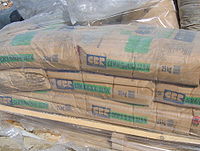
Photo from wikipedia
Abstract In Thailand, the residues of the quarrying process are classified as industrial waste. The residues can block the drainage system, causing the country's flooding problem. This research focused on… Click to show full abstract
Abstract In Thailand, the residues of the quarrying process are classified as industrial waste. The residues can block the drainage system, causing the country's flooding problem. This research focused on producing burned bricks for construction with the utilization of the residues. In this experiment, the residues and clay were mixed at different ratios:0%, 40%, 50%, 60%, 70%, and 80% by weight, and then burned at different temperature levels: 900 °C, 1000 °C, and 1100 °C.The results showed that the condition of 50%–60% content of the residues, burned at 1000–1100 °C gave the high compressive strength of 42.50–43.67 MPa.The 40%–60% residues mixed with clay could increase the compressive strength, which was 1.5 times greater than the case of clay (or 0% residue). In addition, at burning 1000–1100 °C had caused the sintering process to result in high compressive strength.
Journal Title: Journal of Building Engineering
Year Published: 2019
Link to full text (if available)
Share on Social Media: Sign Up to like & get
recommendations!